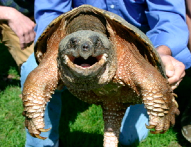I wanna see some NATURE!
By Mary Bigelow
Posted on 2011-06-06
 Last weekend, I did volunteer work at a county park nature center. Many people were taking advantage of the beautiful weather: walking the trails, birdwatching, biking, running, and picnicking. When a family came in to the building to see the displays, I said hello and asked if I could help them find something. The little girl (about 3 years old or so) looked up and said in a matter-of-fact tone, “I wanna see some NATURE!” (emphasis on the word nature).
Last weekend, I did volunteer work at a county park nature center. Many people were taking advantage of the beautiful weather: walking the trails, birdwatching, biking, running, and picnicking. When a family came in to the building to see the displays, I said hello and asked if I could help them find something. The little girl (about 3 years old or so) looked up and said in a matter-of-fact tone, “I wanna see some NATURE!” (emphasis on the word nature).
Her enthusiasm got me thinking—how many children are encouraged to “see some nature,” whether in a schoolyard, park, nature center, wildlife refuge, zoo, arboreteum, botanical garden, or even their own backyards and neighborhoods? How many children get the chance to plant a garden or even a single plant and watch it grow? How many children are encouraged to observe cloud formations, study the behavior of bugs, or collect rocks? How many can identify common birds and trees in their communities?
Getting children interested in nature can lead to lifelong learning. This phrase is in many schools’ mission statements but is often just that—a statement. After the little girl and her family left for the trails, I saw some active examples of lifelong learning related to nature. A woman came in and gazed intently at the list of bird sightings. She noted that someone had seen a “common moorhen.” She was perplexed because her bird guide used the name “common gallinule.” We looked at several guides at the center, and depending on the publication year, different common names were used for the same bird. But we saw that the scientific name was the same in all of the references.
A 20-something man came in next. It was his first visit to the park, and he was excited about seeing some frogs and a salamander. He wasn’t sure what they are, so he took some photos with his cell phone. We identified the frog (green) and the salamander (dusky). He took a copy of the center’s guide for his next visit.
How do we foster an interest (and a passion) for lifelong learning? Citizen science projects such as those sponsored by the Cornell Lab of Ornithology are popular ways to make science interesting and they can lead to lifelong interests. A popular program at our nature center is Adopt-a-Turtle. Modest donations are used to fund a college study in which small microchips are embedded in resident turtles. Periodically they are monitored for their growth and behavior patterns, and donors will get reports on “their” turtles.
As you’re planning classroom activities for next year (or your own vacation events), NSTA journals have many articles related to nature study, complete with lesson ideas and examples of student work. Many of these activities take place right in the schoolyard or nearby parks or green spaces. You can search the SciLinks database for web-based resources related to plants, animals, the environment, and ecological topics. Most parks and nature centers have websites and post updates and events on Facebook and Twitter.
When it started to rain later in the afternoon, the little girl and her family came back to the nature center. She was so excited to describe the NATURE she had seen—turtles, egrets, geese, and chipmunks. I think we have a future naturalist in our community. I hope that the schools are ready for her.
Disclaimer: The views expressed in this blog post are those of the author(s) and do not necessarily reflect the official position of the National Science Teaching Association (NSTA).


